Anycubic recently introduced the Wash & Cure Max, an extra-large volume, with a one-click option washing and curing station. While other Anycubic Wash & Cure stations have proven popular for smaller models, the Max model is designed to handle many items at once or an extra large resin print. This machine also claims to be alcohol-efficient as the consumption should be reduced in comparison to other stations. In this review, we’ll take a look at the capabilities of this new cleaning and curing station, and see how well it improves the whole resin 3D printing experience.
Table Of Contents
- Specifications
- Unboxing – What’s Included
- Assembly and Setup
- Volume and Design
- Washing and Curing
- Maintenance
- Results
- Compare to Other Stations
- Conclusion and Pros & Cons
Anycubic Wash & Cure Max Specifications
Max Volume: 14.9L
Max. Cleaning Size: 300*165*300mm (11.8″x6.5″x11.8″)
Max. Object Weight: 2.2kg
Rotating Curing Platform
One-click Washing and Curing Option
Dual Cleaning Mode
Price: $359-389
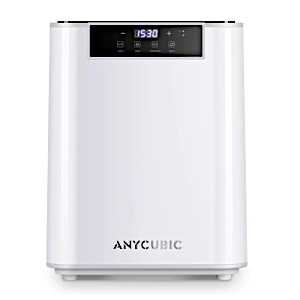
What’s in the Box
Wash and Cure Max arrives in a big but not too heavy box. Here is the list of included parts and accessories:
• Wash & Cure Max
• Tray
• Detergent Container
• Water Container
• Collapsible Bucket
• 4 Tubes
• Hex Key Set
• Scraper
• Filter Replacement
• Power Supply
• User Manual
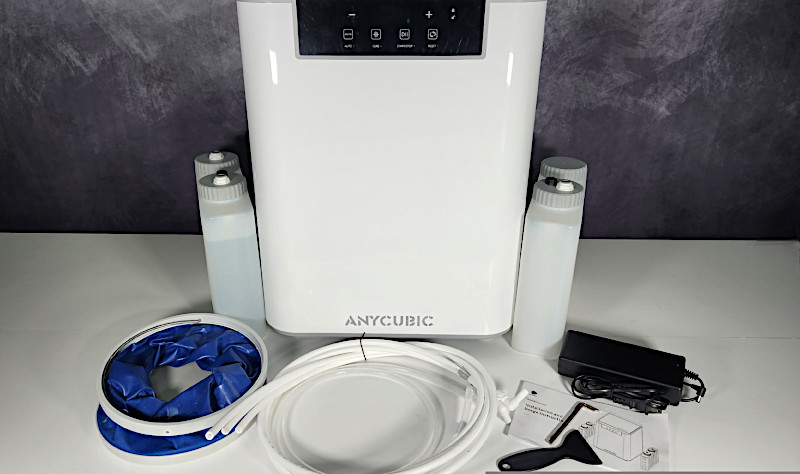
©3DWithUs – Photo: Will Zoobkoff
Assembly and Setup
Four hoses with quick-connect connectors are included in the packing, securing connection to the detergent containers. Three of these hoses are used to extract washing solutions from the machine, including the recovery of IPA used in the initial cleaning stage and returning it to the main container. Meanwhile, the translucent hose is responsible for removing the water used in the second cleaning stage.
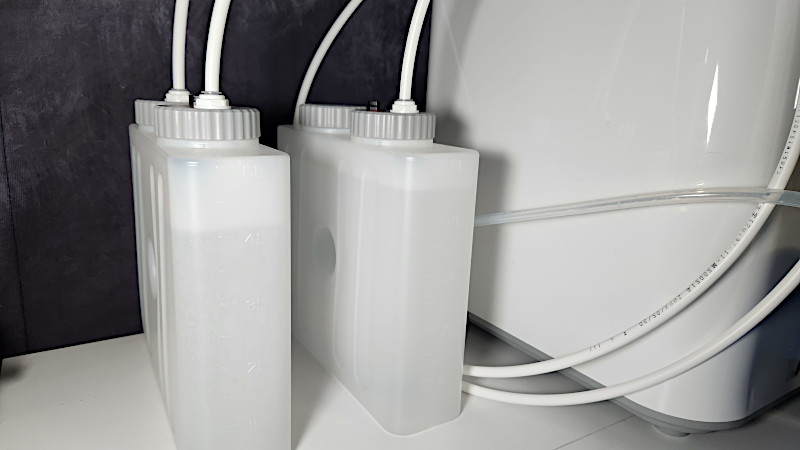
©3DWithUs – Photo: Will Zoobkoff
In terms of the containers, the unit has two rectangular attachments that can hold up to 5 liters of fluid each. The first container is for the major washing fluid, whether it is IPA or another washing detergent, and the second container is for water deployment in the last wash before the curing process. These containers have top caps for hose connections from the machine, allowing for easy filling and emptying based on your needs. Furthermore, each container includes a part that extends to the bottom, ensuring effective liquid pumping into the unit as needed.
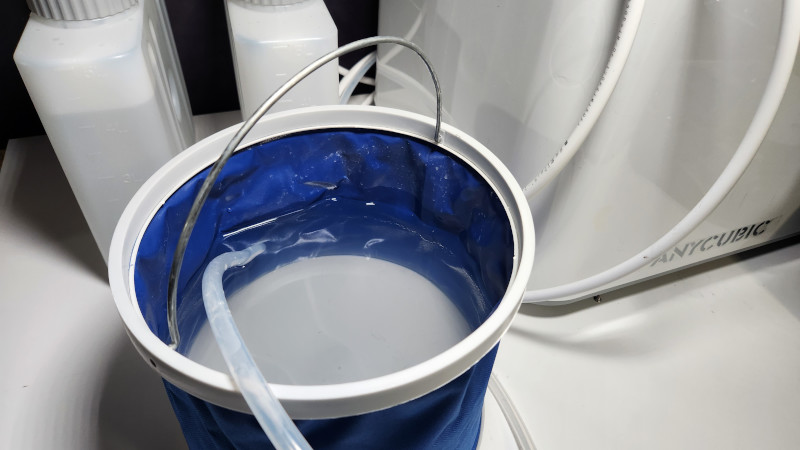
©3DWithUs – Photo: Will Zoobkoff
Unfortunately, the translucent hose cannot be used for liquid recovery, prohibiting the machine from acting as a two-stage washing station—the first wash using the original container, followed by a second wash for complete cleaning and IPA recovery. Anycubic offers an alternative solution, instructing consumers to collect liquid from the second wash in the collapsible bucket provided with the machine and follow correct disposal procedures in accordance with local laws.
Setup is simple: simply connect the appropriate hose to the individual inlet of each container. The detergent container has two connected hoses, one for input into the device and one for return. In contrast, the water rinse container has only one connecting line. The final clear line empties into the provided bucket or another container of your choice.
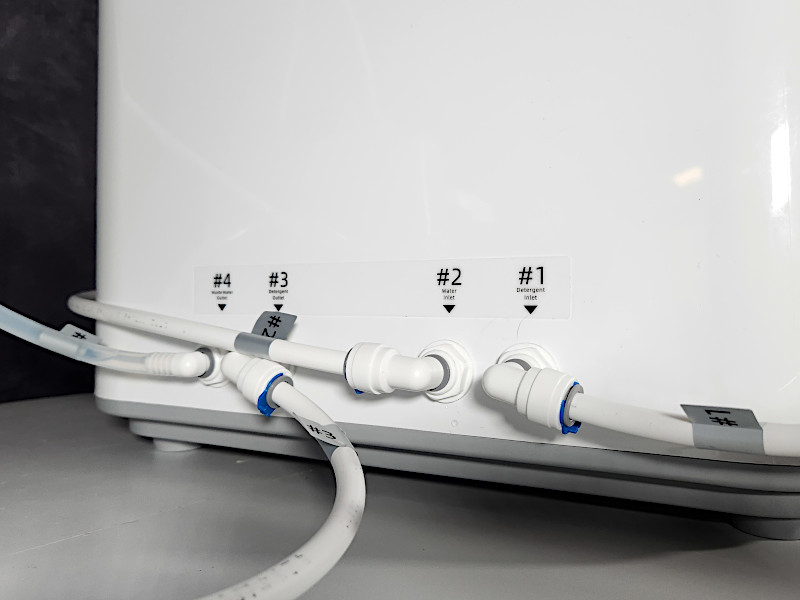
©3DWithUs – Photo: Will Zoobkoff

The Anycubic Wash & Cure Max features a magnetic locking system that keeps the lid secure during the cleaning and curing procedures, preventing leaks and UV light eye damage.
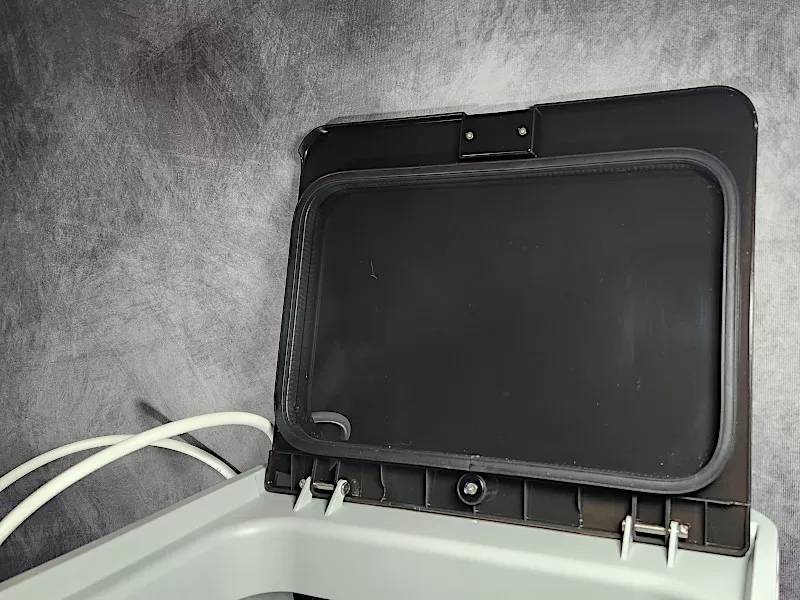
©3DWithUs – Photo: Will Zoobkoff
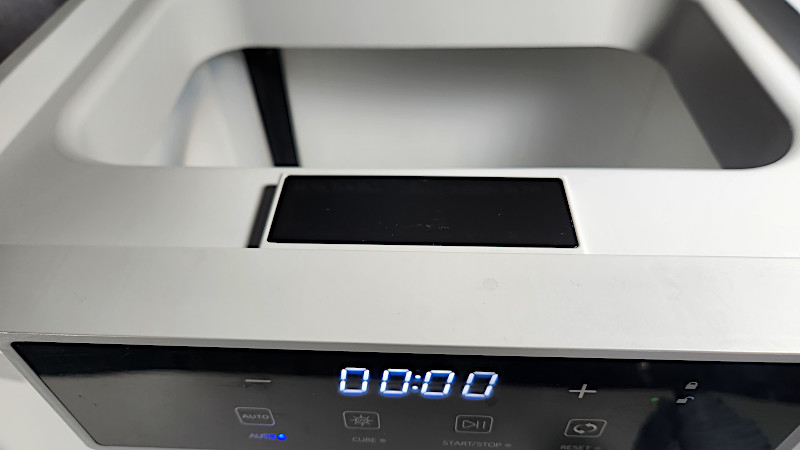
Volume and Design – Portable Washing Machine
However, it’s worth mentioning that the design, while beneficial, is extremely enormous, necessitating a significant amount of room in your workspace. And of course, this machine would be enough as a post-processing station for most, even extra large resin 3D printers available on the consumer market. Anycubic has generously provided adequate tubing length for each line, allowing us flexibility in container placement and the ability to shorten the lines as needed.

©3DWithUs – Photo: Will Zoobkoff
Drawing similarities between the Anycubic Wash & Cure Max and a dishwasher or washing machine appears appropriate at first glance. This equipment, which is mostly made of white plastic, resembles a portable washing machine and has a sleek and clean design. The black control interface, which houses a pair of capacitive buttons for easy interaction, complements its user-friendly features. While the sides of the device are basic white, the back houses the power button and connections for tubes that link to containers containing washing fluids.
The Anycubic Wash & Cure Max has a large overall volume of nearly 15 liters. The actual washing size of a model, on the other hand, is decided by what fits in the provided washing tray — a plastic tray volume is 165x300mm. The tray lies on the plastic rotational unit at the bottom of the Wash & Cure station, which is provided with four additional ball bearings to support the weight of the model during washing and curing.
Examining the unit’s bottom exposes a pair of metallic wire mesh filters that have been precisely placed to prevent minute fragments of cured resin from accessing the pumps. Unfortunately, no technique exists to filter the Isopropyl Alcohol (IPA) of the uncured resin that is drawn back into the containers.
Washing and Curing
The Anycubic Wash & Cure Max simplifies the process of washing and cleaning resin parts with a simple one-button activation—simply press the Auto button, and the device seamlessly completes the washing and curing cycle in around 15 minutes. A clever safety mechanism ensures that the top cover remains secured during this operation, preventing any effort to open it while the machine is running. This is especially important given the presence of poisonous vapors from Isopropyl Alcohol (IPA) and the possibility for fire caused by IPA spraying.
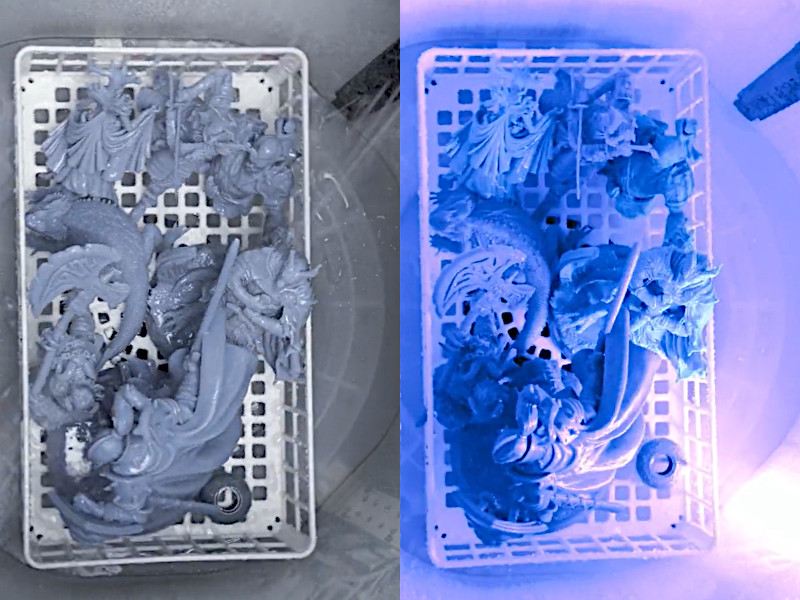
Image: Anycubic
Despite the unit’s user-friendly design, wiping off the spray nozzles is a small but necessary step to guarantee no resin residue remains. It’s a minor effort that ensures the cleaning process’s effectiveness.
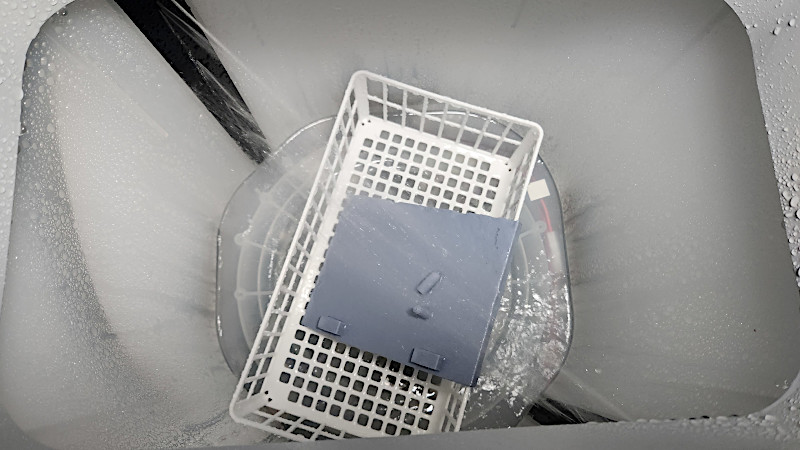
©3DWithUs – Photo: Will Zoobkoff
A notable feature is the auto mode’s seamless transition from the cleaning to the curing cycle.
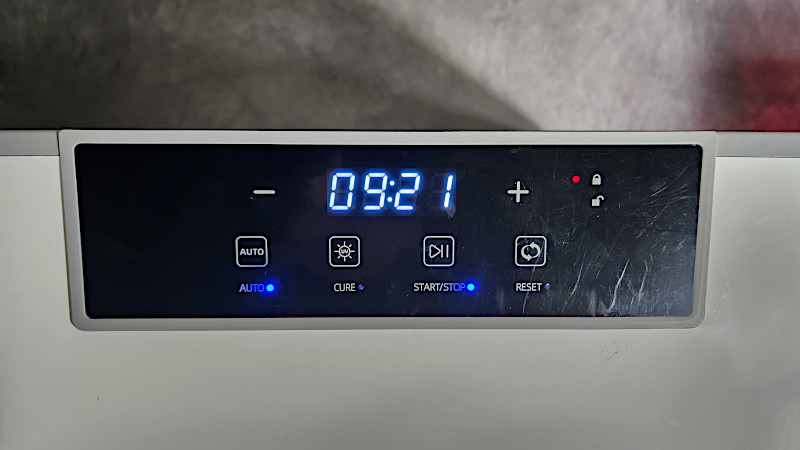
©3DWithUs – Photo: Will Zoobkoff
It is best to remove supports before placing prints in the wash and cure for best results, since cured supports might be difficult to remove. Personalization becomes important, with consumers, including myself, preferring dry models prior to curing. To fulfill this need, pausing the auto cycle at 4:30 allows models to be removed and completely dried before continnuing with the curing process. A separate wash and cure cycle would have greater versatility for consumers looking for more control over their workflow.

When the cycle is finished, the models can be safely removed. It is recommended to perform an additional drying step, especially given the quick rinse that occurs after the curing process in auto mode. It’s worth noting that when utilizing the cure button alone, this rinse is skipped. Following curing, the pump activates to remove any remaining fluid from the machine.
Maintenance
After each cycle, it’s a good idea to give the nozzles in the two corners a quick wipe down. This preventative approach aids in the prevention of future blockages, helping to the general maintenance and longevity of the Anycubic Wash & Cure Max.
Results
After multiple wash and cure cycles, the Anycubic Wash and Cure Max consistently succeeded in fully cleaning models prior to the curing process. The dual rows of spray nozzles performed admirably, delivering a thorough rinse and cleaning throughout the cycle. Following the wash cycle, a quick water rinse guaranteed that the models were clean and ready for curing. To improve the process, I removed all supports before putting the models through the wash and cure, expecting probable issues in removing supports after the cycle.
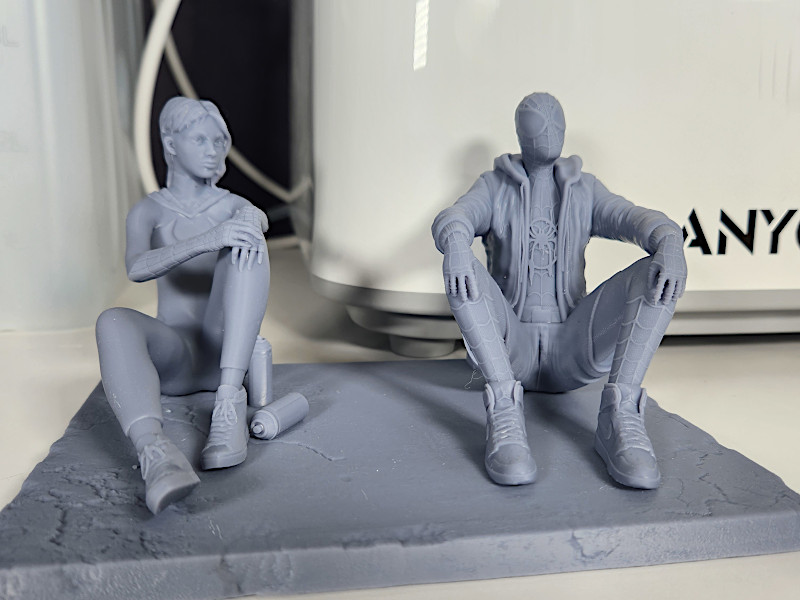
3D Model by B3Dserk on Patreon
©3DWithUs – Print and Photo: Will Zoobkoff
All of the printed pieces were immaculate, free of any resin residue, and there were no lingering white patches, which are frequently associated with poor resin removal, especially in grey resin prints. While the nozzles effectively reached different portions of the print, it’s worth mentioning that the inside of hollowed models may not be washed as thoroughly as an immersed washing system might.

3D Model by B3Dserk on Patreon
©3DWithUs – Print and Photo: Will Zoobkoff
Overall, the Anycubic Wash and Cure Max produced excellent results, ensuring clean and residue-free prints after curing. The only disadvantage is the wastewater generated at the end of each cycle, which presents disposal issues based on local rules. Anycubic recommends leaving the liquid in a container for several days to let the resin to settle before sun curing and disposal. In my experience with grey resin, the rinse water did not settle, probably due to the resin pigment, leaving a slight resin odor.
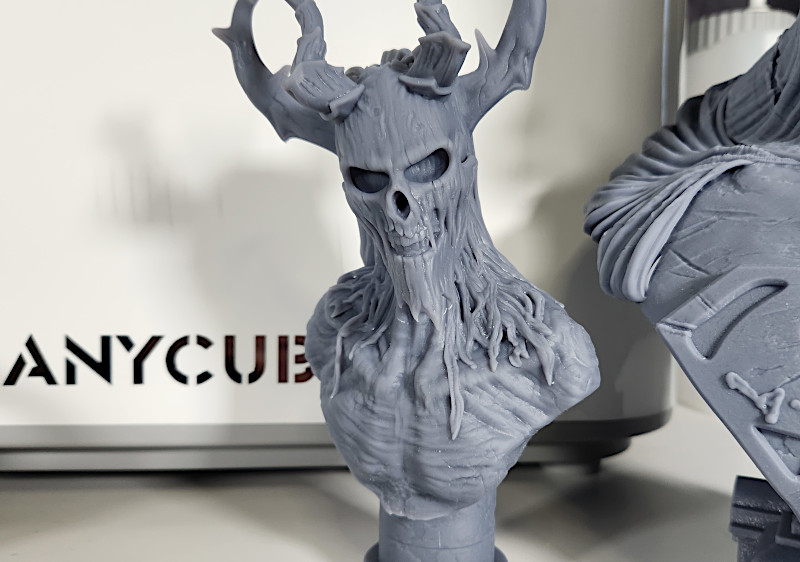
3D Model by Fotis Mint on Patreon
©3DWithUs – Print and Photo: Will Zoobkoff
Despite these factors, the Anycubic Wash & Cure Max excels at producing consistently clean prints because to its dual rows of effective spray nozzles. The auto mode’s movement from cleaning to curing in a single cycle simplifies the operation, however some users may prefer more personalization options.

©3DWithUs – Print and Photo: Will Zoobkoff
In essence, the Anycubic Wash & Cure Max remains a significant asset for people with plenty of workspace and a requirement for high-capacity resin processing. While it is not without flaws, its ability to produce pristine, residue-free prints after curing establishes its status as a prominent rival in the area of resin 3D printing solutions.
Compare Anycubic Wash & Cure Max to Other Products
Anycubic Wash & Cure Max is unique for the consumer market machine as it is first an all-in-one solution that combines part washing, part drying, and part curing processes in one go. It is a strong attempt to change messy post-processing into a one-click experience. To compare to other similar products available on the market, please read our detailed comparison Wash and Cure Stations comparison guide.
Compare to other Wash & Cure Stations:
I am pleased to see Anycubic keeps producing new post-processing solutions and now they have a wide range to meet all needs.
Conclusion and Pros & Cons

Anycubic Wash & Cure Max Review
Review Summary
If you need a wash and cure station with a large capacity and a contained system, there are not a lot of those on the consumer market. The Anycubic Wash & Cure Max is a decent option. One notable disadvantage is that the IPA is recycled back into the clean IPA, resulting in a relatively short lifespan for the wash fluid’s effectiveness. A filtration device that would collect uncured resin could be a significant improvement. Nevertheless, the Anycubic Wash & Cure Max emerges as a potential option if you have the space to accommodate it. The flexibility of this station to handle many prints at once or an extra large print can considerably speed up and improve your workflow.
PROS
• 14.9 litre volume
• Large basket
• Less IPA used overall
• Self contained fluid containers
CONS
• No seprare wash cycle
• IPA recyles into clean
• Rinse water each cycle



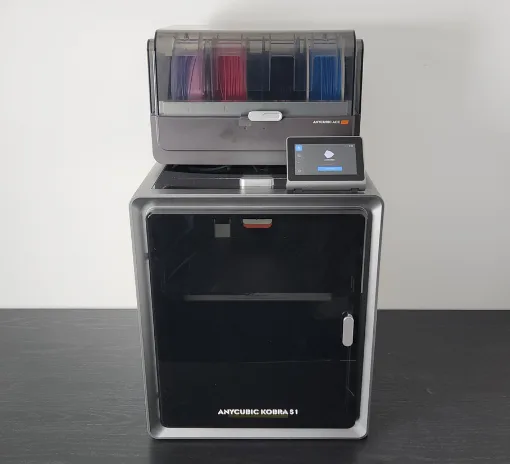

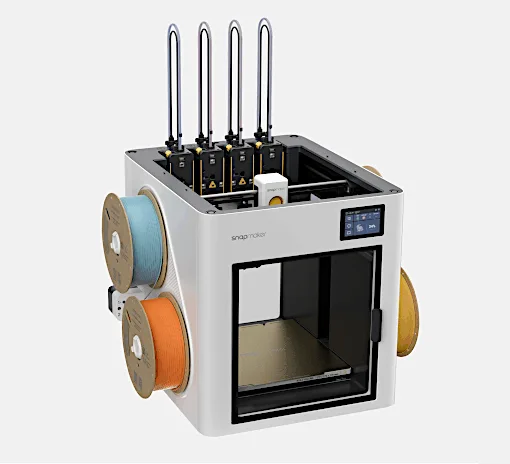
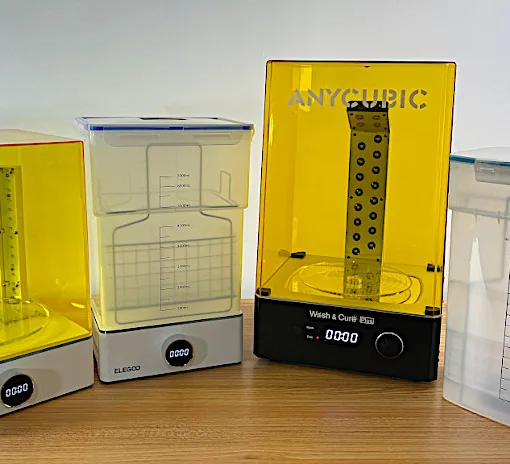
One big and dangerous con is spraying IPA that makes hazardous area by vapours. Its enough one spark and the “washing machine” is all around your home